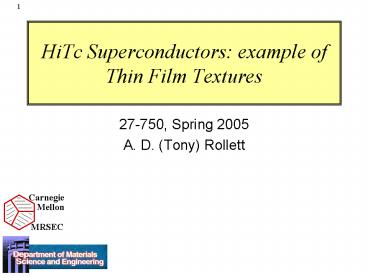HiTc Superconductors: example of Thin Film Textures - PowerPoint PPT Presentation
1 / 13
Title:
HiTc Superconductors: example of Thin Film Textures
Description:
Dependence of film orientation on deposition temperature ... Remaining research & development challenge: currently, the mosaic spread in the ... – PowerPoint PPT presentation
Number of Views:112
Avg rating:3.0/5.0
Title: HiTc Superconductors: example of Thin Film Textures
1
HiTc Superconductors example of Thin Film
Textures
- 27-750, Spring 2005
- A. D. (Tony) Rollett
2
High Temp. Superconductors
- Performance the main criterion for performance
for High critical temperature superconductors is
current density, JC. The second criterion is
length of conductor over which a minimum level of
conductivity can be guaranteed. In other words,
high JC is useless unless it can be obtained over
the entire length of the required wire.
3
Manufacturing Strategies
- There have been two main strategies for making
long lengths of superconducting tape/wire. - Enclose the (brittle) oxide superconductor in a
ductile metallic sheath, e.g. BSSCO on silver. - Deposit thin layers of the superconductor, e.g.
YBCO on a Ni substrate, in a way that ensures
epitaxy, i.e. alignment of the oxide crystals
with the substrate crystals.
4
IBAD
- IBAD Ion Beam Assisted Deposition
- The principle is to use a highly (cube-)oriented
metal substrate and deposit buffer layers,
followed by superconductor layers. - The buffer layers protect the superconductor
(generally YBCO) from the metal (typically Ni)
because the metal poisons the superconductor.
5
Epitaxial Deposition
- Several layers are used in between the metal tape
and the final superconductor layer. Typical
layer thicknesses are small fractions of 1 µm.
6
YBCO
- Two forms of anisotropy apply in YBCO the
conduction property is essentially confined to
the a-b plane (i.e. 001, left hand chart). Also,
any boundary above a few degrees in
misorientation blocks the current (right hand
chart). - Bi-axial alignment is therefore critical.
7
YBCO on Substrate
- A YBCO crystal is not far from cubic (tetragonal
but with c/a 1). Therefore it can deposit
epitaxially on a (single crystal) substrate with
either the c-axis perpendicular to the film
plane, or parallel to it.
c?
c?
a?
a?
LaAlO3
8
YBCO on various substrates
c?
a?
YBCO is nearly cubic, so it can deposit with
either the c-axis or the a-axis parallel to the
substrate surface
Note the different positions of the (102) peak
for the c? a ? orientations
Theoreticalpole figuresfor c? a ?
9
YBCO (123) on various substrates
c?
a?
Various epitaxialrelationshipsapparent fromthe
pole figures
More a? grainsMore c? grains
10
High Resolution Scan ?a 0.5, ?b 0.2
Azimuth, b
Tilta
High resolution scans permit detailed analysis of
peak shape, e.g. measurement of
full-width-half-maximum (FWHM).
11
Dependence of film orientation on deposition
temperature
Ref Heidelbach, F., H.-R. Wenk, R. E.
Muenchausen, R. E. Foltyn, N. Nogar and A. D.
Rollett (1996), Textures of laser ablated thin
films of YBa2Cu3O7-d as a function of
deposition temperature. J. Mater. Res., 7,
549-557.
Impact superconduction occurs in the
c-planetherefore c? epitaxy is highly
advantageous tothe electrical properties of the
film.
12
Summary
- By choosing an appropriate substrate (one with
similar lattice parameter), a high Tc
superconductor can be induced to deposit
epitaxially, i.e. with all its crystals aligned
with the crystal(s) of the substrate. - A well researched approach is to start with a
highly aligned (cube textured) metal tape (e.g.
Ni) and deposit various buffer layers with a
final layer of the superconductor. With careful
control of the deposition conditions, epitaxy is
preserved throughout the various layers, allowing
a highly aligned, long superconductor tape to be
manufactured. - Remaining research development challenge
currently, the mosaic spread in the substrate is
about 1. It would be very useful to bring the
spread down and decrease the magnitude of the
misorientation at grain boundaries in the
superconductor.
13
Notes epitaxial films
- If epitaxy of any kind occurs between a film and
its substrate, the (inevitable) difference in
lattice parameter(s) will lead to residual
stresses. Differences in thermal expansion will
reinforce this. - Residual stresses broaden diffraction peaks and
may distort the unit cell (and lower the crystal
symmetry), particularly if a high degree of
epitaxy exists. - Mosaic spread, or dispersion in orientation is
always of interest. In epitaxial films, one may
often assume a Gaussian distribution about an
ideal component and measure the standard
deviation or full-width-half-maximum (FWHM).































